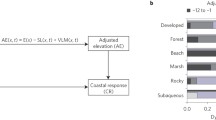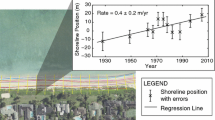Abstract
Sea-level rise will increase the risks associated with coastal hazards of flooding and erosion. Along the active tectonic margin of California, the diversity in coastal morphology complicates the evaluation of future coastal hazards. In this study, we estimate future coastal hazards based on two scenarios generated from a downscaled regional global climate model. We apply new methodologies using statewide data sets to evaluate potential erosion hazards. The erosion method relates shoreline change rates to coastal geology then applies changes in total water levels in exceedance of the toe elevation to predict future erosion hazards. Results predict 214 km2 of land eroded by 2100 under a 1.4 m sea level rise scenario. Average erosion distances range from 170 m along dune backed shorelines, to a maximum of 600 m. For cliff backed shorelines, potential erosion is projected to average 33 m, with a maximum potential erosion distance of up to 400 m. Erosion along the seacliff backed shorelines was highest in the geologic units of Cretaceous marine (K) and Franciscan complex (KJf). 100-year future flood elevations were estimated using two different methods, a base flood elevation approach extrapolated from existing FEMA flood maps, and a total water level approach based on calculations of astronomical tides and wave run-up. Comparison between the flooding methods shows an average difference of about 1.2 m with the total water level method being routinely lower with wider variability alongshore. While the level of risk (actual amount of future hazards) may vary from projected, this methodology provides coastal managers with a planning tool and actionable information to guide adaptation strategies.










Similar content being viewed by others
Notes
Hapke et al. (2006) also used the best available LIDAR dataset, a 1998 post El Niño survey. Large sediment deposition associated with high rainfall and discharge was identified as a likely cause of highaccretion rates. Realistic value selected after consultation (Hapke Pers.Comm)
References
Army Corps of Engineers (2005) Corps of Engineers Coordinate Conversion Corpscon Version 6.0. April 26, 2005. http://crunch.tec.army.mil/software/corpscon/corpscon.html
Adams PN, Inman DL, (2009) Climate change and potential hotspots of coastal erosion along the southern California coast. California Climate Change Center. CEC-500-2009-022-F
Allan JC, Komar PD (2006) Climate controls on US West Coast erosion processes. J Coast Res 22(3):511–529
BCDC (2008) San Francisco Bay Conservation and Development Commission (BCDC), 1-meter sea level rise scenarios in San Francisco Bay inundation maps. http://www.bcdc.ca/gov
Benumof BT, Griggs GB (1999) The dependence of seacliff erosion rates, cliff material properties, and physical processes: Sand Diego County, California. Shore and Beach 67(4):29–41
Benumof B, Storlazzi C, Seymour R, Griggs G (2000) The relationship between incident wave energy and seacliff erosion rates: San Diego County, California. J Coast Res 16(4):1167–1178
Bruun P (1962) Sea level rise as a cause of shore erosion. J Waterways Harbors Div 88:117–130
Budetta P, Galietta G, Santo A (2000) A methodology for the study of the relation between coastal cliff erosion and the mechanical strength of soils and rock masses. Eng Geol 56:243–256
Carter CH, Guy DE (1988) Coastal erosion: processes, timing and magnitude at the bluff toe. Mar Geol 84:1–17
Cayan D, Tyree M, Dettinger M, Hidalgo H, Das T, Maurer E, Bromirski P, Graham N, Flick R (2009) Climate change scenarios and sea level rise estimates for California 2008 climate change scenarios assessment. CEC-500-2009-014-F
CDIP (2008) Coastal Data Information Program (CDIP), Scripps Monitoring and Prediction (MOP) System. http://cdip.ucsd.edu/documents/index/product_docs/mops/mop_intro.html
Collins BD, Sitar N (2008) Processes of coastal bluff erosion in weakly lithified sands, Pacifica, California, CA. Geomorphology 97:483–501
Dean RG, Maurmeyer EM (1983) Models for beach profile response. In: Komar P (ed) Handbook of coastal processes and erosion. CRC, Boca Raton, pp 151–165
Edil TB, Vallejo LE (1980) Mechanics of coastal landslides and the influence of slope parameters. Eng Geol 16:83–96
Emery KO, Kuhn GG (1982) Sea cliffs: their processes, profiles, and classification. Geol Soc Am Bull 93:644–654
Everts CH (1985) Sea level rise effects on shoreline position. J Waterw, Port, C-ASCE 111(6):985–999
FEMA (2005) Final draft guidelines, coastal flood hazard analysis and mapping for the Pacific Coast of the United States. Prepared for the U.S. Department of Homeland Security
Fisher JS, Overton MF (1984) Numerical model for dune erosion due to wave uprush. Proceedings of the 19th Coastal Engineering Conference. ASCE pp 1553–1558
Flick RE, Ewing LC (2009) Sand volume needs of southern California beaches as a function of future sea level rise rates. Shore and Beach 77(4):36–45
Gleick PH, Maurer EP (1990) Assessing the costs of adapting to sea-level rise: a case study of San Francisco Bay. Pacific Institute for Studies in Development, Environment, and Security. Berkeley, CA and the Stockholm Environment Institute, Stockholm, Sweden. 57 pp with 2 maps
Graham N, Diaz H (2001) Evidence for intensification of North Pacific winter cyclones since 1948. Bull Am Meteorol Soc 82(9):1869–1893
Griggs G, Patsch K, Savoy L (2005) Living with the changing California Coast. University of California Press, Berkeley and Los Angeles
Habel JS, Armstrong GA (1978) Assessment and atlas of shoreline erosion along the California coast. California Department of Navigation and Ocean Development. 277 p
Hampton MA, Griggs G (2004) Formation, evolution, and stability of coastal cliffs—status and trends. U.S. Geological Survey (USGS) Professional Paper 1693. http://pubs.usgs.gov/pp/pp1693
Hapke CJ, Reid D, Richmond BM, Ruggiero P, List J (2006) National assessment of shoreline change Part 3: Historical shoreline change and associated coastal land loss along sandy shorelines of the California Coast. U.S. Geological Survey Open File Report 2006–1219
Hapke CJ, Reid D (2007) National assessment of shoreline change part 4: Historical Coastal Cliff Retreat along the California Coast. U.S. Geological Survey Open File Report 2007–1133
Hapke CJ, Reid D, Richmond BM (2009) Rates & trends of coastal change in California & the regional behavior of the beach and cliff system. J Coast Res 25(3):603–615
Heberger M, Cooley H, Herrera P, Gleick PH (2009) The impacts of sea level rise on the California Coast. California Climate Change Center . CEC-500-2009-024-F
Intergovernmental Panel on Climate Change (IPCC) (2007) Climate Change 2007: The Physical Science Basis: Summary for Policymakers. Contribution of Working Group I to the Fourth Assessment Report of the Intergovernmental Panel on Climate Change
Knowles N (2009) Potential inundation due to rising sea levels in the San Francisco Bay region. California Climate Change Center. CEC-500-2009-023-D
Komar PD, Shih SM (1993) Cliff erosion along the Oregon coast; a tectonic sea level imprint plus local controls by beach processes. J Coast Res 9:747–765
Komar PD, McDougal WG, Marra JJ, Ruggiero P (1999) The rational analysis of setback distances: applications to the Oregon Coast. Shore and Beach 67(1):41–49
Kriebel DL, Dean RG (1985) Numerical simulation of time dependent beach and dune erosion. Coast Eng 9:221–245
Larson M, Erikson L, Hanson H (2004) An analytical model to predict dune erosion due to wave impact. Coast Eng 51:675–696
Leatherman SP (1984) Coastal geomorphic responses to sea-level rise, Galveston Bay, Texas. In: Barth MC, Titus JG (eds) Greenhouse effect and sea-level rise: a challenge for this generation. Van Nostrand Reinhold, New York
MacArthur RC, Dean R, Battalio RT (2006) Wave processes in nearshore environment for hazard identification. In: Smith JM (ed) Coastal Engineering 2006. Proceedings of the 30th International Conference. San Diego, CA. pp 1775–1787
National Research Council (1987) Responding to changes in sea level: engineering implications. National Academy Press, Washington D.C
Nishi R, Kraus NC (1996) Mechanism and calculation of sand dune erosion by storms. Proceedings of the 25th Coastal Engineering Conference. ASCE, pp 3034–3047
O’Reilly WC, Guza RT (1993) Comparison of two spectral wave models in the Southern California Bight. Coast Eng 19:263–282
O’Reilly WC, Seymour RJ, Guza RT, Castel D (1993) Ocean Wave Measurement and Analysis, Proc 2nd Int Symp July 25–28, 1993. pp 448–457
Pilkey OH, Young RS, Riggs SR, Smith AWS, Wu H, Pilkey WD (1993) The concept of shoreface profile equilibrium: a critical review. J Coast Res 9(1):255–278
Rahmstorf S (2007) A semi-empirical approach to projecting future sea-level rise. Science 315:368–370
Revell DL, Komar PD, Sallenger AH (2002) An application of LIDAR to analyses of El Niño erosion in the Netarts Littoral Cell, Oregon. J Coast Res 18(4):702–801
Robinson LA (1977) Marine erosive processes at the cliff foot. Mar Geol 23:257–271
Ruggiero P, Komar PD, McDougal WG, Beach RA (1996) Extreme water levels, wave run-up and coastal erosion. Proceedings of the 25th International Conference on Coastal Engineering. ASCE 2793–2805 p
Ruggiero P, Komar PD, McDougal WG, Marra JJ, Beach RA (2001) Wave run-up, extreme water levels, and the erosion of properties backing beaches. J Coast Res 17(2):401–419
Ruggiero P (2008) Impacts of climate change on coastal erosion and flood probability in the US Pacific Northwest. In Solutions to Coastal Disasters 2008. Oahu Hawaii, 158:169
Ruggiero P, Komar PD, Allan JC (2010) Increasing wave heights and extreme value projections: The wave climate of the U.S. Pacific Northwest, Coastal Engineering, doi:10.1016/j.coastaleng.2009.12.005
Ryan HF, Parsons T, Sliter RW (2008) Vertical tectonic deformation associated with the San Andreas fault zone offshore of San Francisco, California, Tectonophysics (2008), doi:10.1016/j.tecto.2008.06.011
Sallenger AH, Krabill W, Brock J, Swift R, Manizade S, Stockdon H (2002) Sea cliff erosion as a function of beach changes and extreme wave run-up during the 1997–1998 El Niño. Mar Geol 187:279–297
San Diego Foundation (2008) Climate change related impacts in the San Diego Region by 2050. Summary prepared for the 2008 Climate Change Impacts Assessment, Second Biennial Science Report to the California Climate Action Team. Prepared by: SAIC, Scripps Institution of Oceanography, and The San Diego Foundation
Stockdon H, Sallenger A, Holman R, List J (2002) Estimation of shoreline position and change using airborne topographic LIDAR data. J Coast Res 18(3):502–513
Stockdon H, Holman R, Howd P, Sallenger AH (2006) Empirical parameterization of setup, swash, and run-up. Coast Eng 53:573–588
Sunamura T (1982) A predictive model for wave-induced erosion, with application to Pacific coasts of Japan. J Geol 90:167–178
Sunamura T (1992) Geomorphology of rocky coasts. Wiley, New York, 302p
Trenhail AS (2002) Modeling the development of marine terraces on tectonically mobile rock coasts. Mar Geol 185:341–363
Wingfield DK, Storlazzi CD (2007) Variability in oceanographic and meteorologic forcing along Central California and its implications on nearshore processes. J Mar Syst 68:457–472
Young AP, Guza RT, Flick RE, O’Reilly WC, Gutierrez R (2009) Rain, waves, and short term evolution of composite seacliffs in southern California. Mar Geol 267:1–7
Acknowledgements
Funding for this study was provided by the California Ocean Protection Council, with support from Dr. Christine Blackburn. This work was part of a larger vulnerability study completed by the Pacific Institute and funded by the California Energy Commission. In particular, we would like to thank Dr. Peter Gleick, Heather Cooley, and Matt Heberger at the Pacific Institute. We also thank Dr. Dan Cayan of USGS and his climate researchers at Scripps—Dr. Reinhard Flick, Dr. Nick Graham, Mary Tyree and Dr. Peter Bromirski. We thank Guido Franco at the California Energy Commission for encouraging this submittal. We would especially like to thank our technical review team who provided timely input—specifically Dr. Cheryl Hapke, Dr. Adam Young, and Dr. Gary Griggs. Dr. Bill O’Reilly of the Coastal Data Information Program voluntarily provided the nearshore wave transformations necessary to improve the spatial resolution of these hazard predictions. Other members of the scientific community who contributed in different ways included Dr. Patrick Barnard, Dr. Kiki Patsch, Dr. Paul Komar, Brian Fulfrost, Lesley Ewing, Clif Davenport, Kim Sterratt, and Nicole Kinsman. Other members of PWA who supported this work include: Jeremy Lowe, Seungjin Baek, Damien Kunz, and Brad Evans. We would also like to thank 3 anonymous reviewers who provided good comments to improve this contribution. Finally, the authors would like to thank the ocean for inspiring and humbling all of our efforts.
Author information
Authors and Affiliations
Corresponding author
Rights and permissions
About this article
Cite this article
Revell, D.L., Battalio, R., Spear, B. et al. A methodology for predicting future coastal hazards due to sea-level rise on the California Coast. Climatic Change 109 (Suppl 1), 251–276 (2011). https://doi.org/10.1007/s10584-011-0315-2
Received:
Accepted:
Published:
Issue Date:
DOI: https://doi.org/10.1007/s10584-011-0315-2




